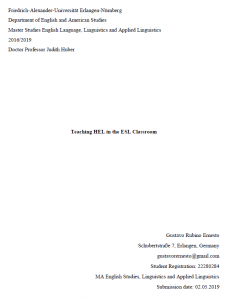PDF #162 – Gustavo Rubino Ernesto – Teaching HEL in ESL Classroom

The main point of this paper is to present a stimulating approach of HEL to ESL students. One major issue in an English as a Second Language (ESL) course that a teacher confront its students with the diversity of English around the globe. Many students already know that English is spoken in many countries but how it came to happen, and its differences are unknown territory to most of them. This paper highlights the most important aspects that should be tackled by students and ESL teachers when facing World Englishes.
In this paper Teaching HEL in ESL Classroom I argue that in order to explain World Englishes teachers need to elucidate the history of the English language and its many changes. Many students lack the knowledge of German and/or Latin to start a HEL course with Old English and because of that many authors suggest that Late Modern English as a more realistic and practical starting point.
Linguistic terms are not very often easy to be taught to those who are not interest in it, but some basic linguistic aspects such as phonology, morphology, lexicon, syntax and semantics need to be explained before addressing the History of the English Language (HEL) but with limited coverage. The course should engage students on the ethical stakes involved in the spread of English, both historically and contemporarily. It should also organize HEL at the same time around a textual tradition chronology. Covering the main points in its history, social and cultural influences, pressures from other languages, internal and external history, synchrony and diachrony, content and structure, conscious and unconscious variations, stability and instability, language difference and identity.
You can check my video on this subject on YouTube.
